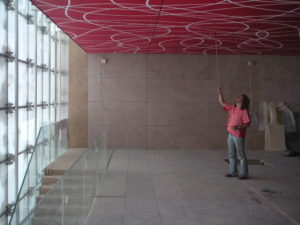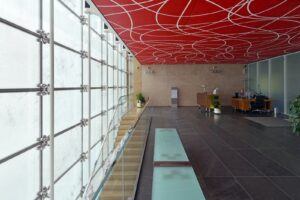- LOADING...
-
Exhibice:Headquaters of Deutsche Bundesbank in Chemnitz, 2004
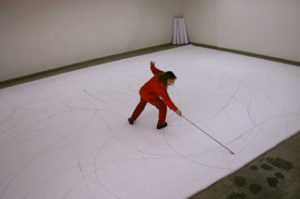
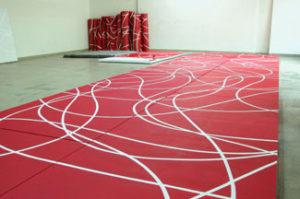
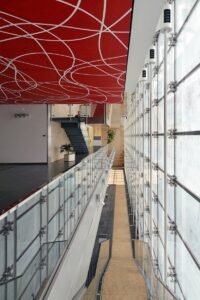
“Ceiling dance” – ceiling painting for Deutsche Bundesbank, in cooperation with architect Joseph Lluis Mateo
Location: Besucher- und Lieferanschrift, Zschopauer Str. 49, 09111 Chemnitz, Německo
This detached building has a simple, compact and, in its appearance, massive, partly transparent design.
The painting on the entrance hall ceiling (exceeding 150 m2 in area) is both a counterpoint to the overall logic of the building and its complement. The paint application technique left the brush strokes visible as a sign of a human, yet artificial intervention in stark contrast to the abstraction of the organic construction materials, free of any trace of craftsmanship.
Retaining the brushwork proved to be of importance in integrating the work within the architectural space, both as a nod to the process of making the painting and an element evoking the organic nature of the painting – a cut through the living tissue of a solid architectural form.
In numerous sketches prepared for the painting I first examined the rhythm of the division relative to the format as well as the harmonization of colours with regards to the materials within the space.
I continued by producing two cardboard paintings at the actual scale in order to be able to precisely determine the density of the network of lines, the magnitude of the waves and their thickness. While working on the cardboards I concluded that waves of this magnitude cannot be drawn using a standard method, as their dimensions surpass the physical capability of a human being. I resorted to attaching the charcoal that I used for drawing on a long pole and, by standing on tip-toe and gyrating the whole body including carefully thought-out legwork, I negotiated smooth curves. I performed something short of a dance during which the body movement is transmitted into the lines drawn. In the next step, when I filled the surfaces with red (the lines were not painted white on red background rather, they were delineated by the adjacent surfaces). I established the degree of brushwork and an appropriate thickness of the white lines relative to the whole area and the assumed spatial relationships.Josep Lluis Mateo, “Petr Kvíčala in Chemnitz”, 2006
Our building for the Bundesbank in Chemnitz is hard, rigid, stone-like and geometrical, as is fitting for the institution it houses. We attempted to endow it with precision, a layer of lightness and a conceptual relationship with nature.
Kvíčala’s intervention gives it an added layer of meaning. Like the rest of the building, his work is passionately crafted.
The artist produced his painting by dancing as if he were performing in a ballet. The hardness of the works in stone on the facade, executed by outstanding stonemasons from Croatia, responded to primitive, slow percussions. The painter entered into a dialogue with them, moving gracefully, freely and lightly. The seemingly erratic grid of white lines on a red background marks an escape route out of the labyrinth and introduces a vital, buoyant atmosphere into the mausoleum of stones.The advance of Kvíčala’s work encouraged us to extend its range still further. Sections of trees were cut and mounted onto the wall at the entrance, creating an affirmation of life, and countering the inevitable hieratism of the architecture. To our mind, building and ceiling always involves thinking about the sky floating above our heads. We also saw Kvíčala’s ceiling in these terms, as red clouds furrowed by white lines. A sky which, despite its dramatic movement, is peaceful, friendly and festive.
externí odkazy:

